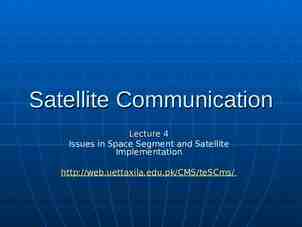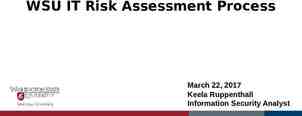PRESENTATION ON SUSTAINABLE DEVELOPMENT AND CORPORATE RESPONSIBILITY
40 Slides414.00 KB
PRESENTATION ON SUSTAINABLE DEVELOPMENT AND CORPORATE RESPONSIBILITY ISSUES 29 April 2003 Anglo American
Presentation Team Sir Mark Moody-Stuart – Chairman John Groom – Safety, Health and Environment Russell King – Human Resources and Business Development Nick Von Schirnding – Investor and Corporate Affairs Edward Bickham – External Affairs
Safety, Health & Environment Dr John Groom
Global Mining Initiative Mining, Minerals and Sustainable Development project GMI Conference, Toronto International Council on Mining and Metals - Characterised by intensive engagement with stakeholders - Provided a solid basis for our participation at the Johannesburg World Summit on Sustainable Development - Anglo American played a key role
International Council on Mining and Metals SD Charter – A commitment to 10 key principles – A commitment to be measured against them International engagement – – – – Global Reporting Initiative Community Engagement tools project with the World Bank World Bank Extractive Industries Review Extractive Industries Transparency Initiative
Report to Society Scope now expanded to become an SD Report Business practices & performance Workplace – Safety – Occupational health – Human resources Environment Society – Community health – Social & community initiatives – Economic contribution Benchmarked against the GRI core indicators
Environment Risk based prioritising – Tackling global issues: using local illustrations Energy and greenhouse gases – Much improved linkage to units of production – Climate change policy – Value-at-risk study completed ISO 14001 certification now covers 51% of turnover. The target is full certification by end of 2004.
Environment Water management – Still reporting in aggregate – Future focus will be on individual businesses where water issues are a priority – For example, Lisheen, Namakwa Sands, Mantos Blancos and Mondi Paper have innovative water-use strategies
Biodiversity Clear strategy Site biodiversity action plans to be developed (where not already in place) – Link to environmental impact assessment and closure planning Corporate contributions to the global challenge – Kew Millenium Seedbank – Active partners in the ICMM/IUCN dialogue on mining and protected areas – Key sponsor of the UNEP World Conservation Monitoring Centre in Cambridge
Environmental Targets Besides the management system targets(ISO14001 and FSC Certification), our business units are setting clear, quantifiable environmental targets that are of greatest relevance to their particular circumstances and their communities. Many such specifics are listed on p. 51 of our report.
Technological Innovations Process R&D and alternatives to traditional smelting (HBMS zinc pressure leach) Sulphate reducing bacteria for water treatment at South African coal mines Coal-bed methane recovery for use (Australia) Energy efficient technologies New smelting process will reduce Anglo Platinum SO2 emissions by 55 000 tonnes/year by end of 2004 Fuel cell technology: joint venture with Johnson Matthey
Legal Compliance 281 incidents were reported involving the regulatory authorities (336 in 2001) Fines paid totalled 162,000 ( 187 000 in 2001) Verification KPMG conducted their third review of our SHE performance and reporting Nine sites visited, and previous site visits reviewed Methane emission reporting remains incomplete
Safety I 2.5 0.10 Lost time injury frequency rates (LTIFR) 2.26 Fatal injury frequency rates (FIFR) 2.0 0.08 1.50 1.5 0.06 1.0 0.04 0.87 0.64 0.5 0.031 0.033 0.02 0.020 0.00 0.0 2000 2001 2002 2003
Safety II 127 000 employees: c.65 000 contractors in managed operations 47 fatal injuries – down by 33% from 2001 Lost-time injuries down by 42% Introduction of Golden Rules Safety performance an element of Executive and Management remuneration Much more remains to be done
Safety III Challenging new targets set Visible felt leadership Training and the promotion of safe behaviour The development of leading indicators The fostering of a true safety culture OTTO: Zero Tolerance, Target Zero Our clear goal is to do business without hurting people
Occupational Health Developed integrated industrial hygiene/ occupational health management guidelines: roll-out commenced Performance audited against the guidelines will provide leading indicators
Human Resources Russell King
Key Issues Decentralised business model but with strong corporate values Corporate role to advise and facilitate Sceptical about utility of data aggregation
Key Data 127 000 employees in managed operations of which: – – – – Africa Europe The Americas Australasia 85 000 30 000 8 500 3 500 Contractors c. 65 000 2002 – no major industrial disputes Support freedom of association – 70% union membership Training – minimum 2.2% of total employment costs
Human Resources – Priority Challenges I DIVERSITY Ensuring equal opportunities throughout the organisation globally Gender c. 10% of employees are women c. 15% in management roles South Africa Employment Equity By 2008, 40% of managerial employees should be HDSAs (c. 22% in 2002) Longstanding programmes to develop HDSA managers, including through educational bursaries c. 600
Human Resources – Priority Challenges II Talent Management – Key aspect of diversity agenda – Part of senior management performance contracts Performance Management and Development – Now cover about half of employees Employee Communication – Developing two-way dialogues
South African Challenges Black Economic Empowerment Nick Von Schirnding
South African Challenges Minerals Development & Petroleum Act Empowerment Charter – 15% equity or production ownership in 5 years – 26% equity or production ownership in 10 years Empowerment Scorecard – Ownership; beneficiation; procurement; employment equity; human resources development; housing conditions and community development Money Bill - consultation
Anglo’s Black Economic Empowerment Commitment US 1.8 billion in BEE transactions completed Procurement expenditure of US 800 million from black-owned businesses 2500 2000 1500 ZAR Millions 1000 500 0 2000 2001 Small business development – – 1999 Currently invested in 20 companies; 1 000 jobs Khula Mining Fund Chairman’s Fund support for education 2002
Social, Community and Economic Issues Edward Bickham
Human Rights Strong commitment in ‘Good Citizenship’ Principles – Support Universal Declaration – Commitment to make representations on behalf of employees and communities Major issues in Zimbabwe Consideration of adherence to ‘Voluntary Principles on Security and Human Rights’ Child labour Development of ‘best practice’ in relation to indigenous peoples
2002 - Controversies Zambia – withdrawal from KCM Colombia – Resettlement Congo – UN Special Panel
HIV/AIDS - I HIV/AIDS policy and strategy development Rigorous scientific reflection 1 9 Linking care to prevention Situating prevention in a community context Developing culturally appropriate prevention messages 8 7 2 Total Management Commitment 6 Challenging denial and stigma 3 4 5 Sustaining awareness and education Tackling socio-economic factors Establishing partnerships
HIV/AIDS - II Voluntary counselling and testing ART initiative for employees (24% infection rate) Treatment protocols in place 30 sites now registered for ART Estimate 3 000 on treatment after 12 months Seeking to broaden coverage of ART Emphasis on community partnerships – – – Zimbabwe Western Cape KwaZuluNatal
Communities I - Objectives Engagement and consultation Enhance capacities / economic upliftment Improved management of socio-economic impacts Community projects to reflect local priorities
Communities II - Engagement Community Engagement Plans – 3-year rolling: – – – – – – Consultation Management of key issues Complaints procedures Contribution to local economy Support for community projects Resources and accountabilities Growth in Community Liaison Panels 2002 – Community Engagement Guidelines and ‘Good Neighbours’ publication
Communities III – Managing Impacts Social Impact Assessment for new projects Rapid Socio-Economic Assessment Methodology – pilot projects: – Mondi Forest, SA – Catalao, Brazil – German Creek, Australia
Communities IV – Economic Upliftment Indigenous management and local labour (eg, Skorpion) Creative use of procurement Income generation schemes Small business development model
Corporate Social Investment CSI Expenditure 35 30 million 25 20 15 10 5 0 1 1999 2 2000 3 2001 4 2002 CSI expenditure US 28.8 million 0.9% of pre-tax profit Priorities: education, health and community development Chairman’s Fund leading social investment vehicle in South Africa ENGAGE campaign – employee volunteering
Economic Contribution Distribution of Benefits Arising from Economic Activity During 2002 ( m) Suppliers 8,730 Employees 2,796 Dividends 1,011 Company Tax 621 Interest 300
Payments to Governments m Taxes and Other Payments to Governments 2002 900 800 700 600 500 400 300 200 100 0 Africa Europe Managed companies North and Aust/Asia South America Non-managed companies
Anglo American's Regional Economic Contribution 2002 7,000 6,000 m 5,000 4,000 3,000 2,000 1,000 Africa Europe North and South America Australia / Asia Value added (non-managed) Value added (managed) Payments to suppliers, indirect taxes and royalties (non-managed) Payments to suppliers, indirect taxes and royalties (managed)
‘Good Citizenship’ – Assurance and Reporting Business Principles Supply Chain contractors suppliers contract compliance Launch Briefings Training Integrate into management processes Provision for whistleblowing KPMG Roll-out Review Internal audit to carry out reviews on request Operations’ Annual Letter of Assurance Divisional CEOs Letters of Assurance Anglo American plc ‘Report to Society’
Embedding ‘Good Citizenship’ Principles Integration into decision-making Development of Programmes – – – – – – Communities Employee communication Business integrity Human rights Whistle-blowing Complaints Supply Chain Issues Improvement of social KPIs
Reporting: What Next? Stakeholder round-tables on evolution of Report Progress towards more divisional and local reporting Examining greater use of web as medium for detailed reporting













































